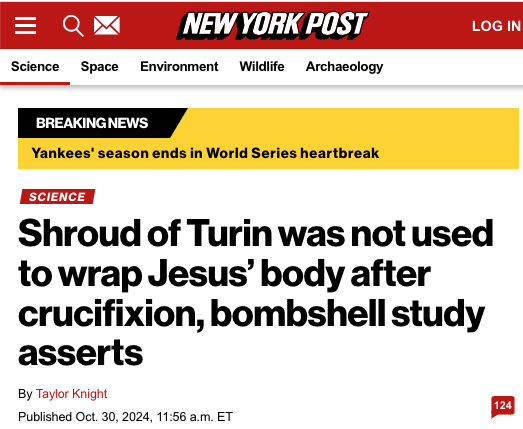
The Shroud of Turin, a centuries-old linen cloth that many believe was used to wrap Jesus’ body after crucifixion, is unlikely to be from Biblical times, hi-tech new research asserts.
“I think the possibility of this having happened is very remote,” said Cicero Moraes, a Brazilian graphics expert, who created a virtual simulation of the shroud to place over an image of a body to see whether impressions on the fabric were a match.
The shroud’s origin can only be traced to the mid-14th century, which has prompted some skeptics to dismiss the cloth as a medieval forgery.
“On one side are those who think it is an authentic shroud of Jesus Christ, on the other, those who think it is a forgery,” Moraes stated. “But I am inclined towards another approach: that it is, in fact, a work of Christian art, which managed to convey its intended message very successfully.”
In order to reach that conclusion, Moraes built a virtual simulation in which a recreation of the shroud was placed over a body.
When laid flat, the virtual fabric showed “a distorted and significantly more robust image” than that on the shroud, as a result of the change from 3D to 2D.
“When you wrap a 3D object with a fabric, and that object leaves a pattern like blood stains, these stains generate a more robust and more deformed structure in relation to the source,” Moraes wrote.
He explained that printing stains from a human body would be more swollen, saying that the impression left by a 3D body shows the striking difference with the shroud.
Moraes noted other findings that did not match up, such as the scalp and toes spread outwardly.
Meanwhile, the torso, groin, and neck area were not imprinted on the cloth.
“It seems to me more like a non-verbal iconographic work that has very successfully served the purpose of the religious message contained within,” Moraes added.
Various historical figures have questioned the legitimacy of the Shroud of Turin for centuries.
Even the Vatican doubted its status in 1390 when Pope Clement VII declared that it was not used to wrap Jesus’ body, instead describing it as “a painting or panel made to represent or imitate the shroud”.
However, in 1506, Pope Julius II reversed course and asserted it was authentic after all.
In the 1970s, microscopist Walter McCrone analyzed the shroud for the Shroud of Turin Research Project (STURP) and found it was painted with pigments of red and vermilion in gelatin. He noticed no blood in the samples, but some of his STURP colleagues dispute his findings.
The Post recently reported on research by University of Padua professor Giulio Fanti, that claimed the Shroud of Turin offered legitimate proof of Jesus Christ’s crucifixion wounds due to the blood stain patterns.
Fanti posited that “the different directions of blood flow from the side wound are discussed, the probable presence of pulmonary fluid” and “some bloodstains” point to trauma suffered by the Savior.
However, other experts called the study a work of crucial fiction, claiming the researcher is acting holier than thou.




